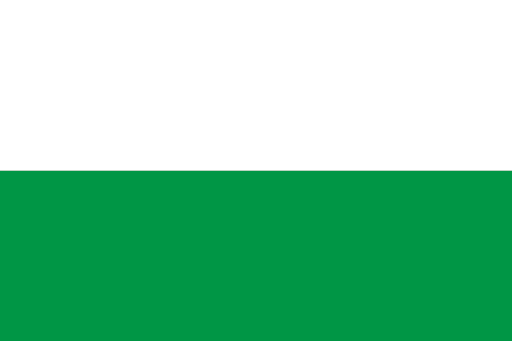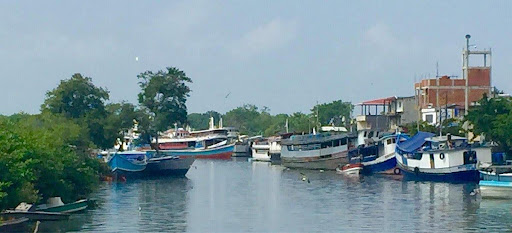Turbo
Department
Antioquia, Colombia

Flag of the city
The flag of the municipality of Turbo in Antioquia features three colors: yellow, green, and blue. This color scheme was proposed by the municipal basketball committee led by Edwin Mathos during the 1970s. The basketball committee urgently required a distinctive emblem to represent their municipality at a sports meet in Frontino. After agreeing upon the colors, the committee assigned the task of crafting the first flag to Adalgiza Uribe de Mathos, the wife of a committee member, as recounted by Edwin Mathos in his oral account from 1996. Later, in August 1990, Agreement 023 formally recognized these chosen colors as the official hues of Turbo’s flag.
Each colour on the flag symbolizes a unique aspect of Turbo. The yellow stripe stands for the town’s wealth, encompassing produce like bananas and plantains, livestock, and underground reserves of coal and oil. The green stripe showcases the town’s rich ecological biodiversity, with its flora and fauna being some of the most diverse on the planet. The blue stripe symbolizes the Gulf of Urabá. Given its strategic location, the gulf is often referred to as “the best corner of Antioquia,” and it’s also home to Turbo’s deep-water port.


Slogan of the city
Turbo is located in the Antioquia department of Colombia. While it may not be a primary destination for many tourists, its significance lies in its function as a transit point. Travelers often pass through Turbo to catch a boat to Capurganá, which subsequently connects them to Puerto Obaldia in Panama
History
Turbo’s history traces back to the arrival of Spanish explorers in the Gulf of Urabá in 1501, with figures like Rodrigo de Bastidas and Juan de la Cosa leading these expeditions. The aftermath saw rampant pillaging, devastating fires, and widespread violence against the indigenous populations, which rendered the area desolate for several centuries.
By the late 18th century, renewed trading activities breathed life and prosperity back into the region. On August 28, 1840, then-President Don José Ignacio de Márquez sanctioned Turbo’s establishment. By 1847, under the leadership of Tomás Cipriano de Mosquera, Turbo was designated as a parochial district. In 1848, the jurisdiction of the nascent municipality fell to the state of Antioquia, but it briefly shifted to Chocó in 1850, and then to the state of Cauca in 1856. It wasn’t until 1910 that Turbo permanently re-joined Antioquia.
Today, Turbo stands as a prominent city in Colombia’s Urabá subregion within the department of Antioquia, and it is the capital of this region. Additionally, Turbo holds the status of a Special Port District. Geographically, Turbo is bordered by the Caribbean Sea and the municipality of Necoclí to the north; by the municipalities of San Pedro de Urabá, Apartadó, and the department of Córdoba to the east; by the municipalities of Carepa, Chigorodó, and Mutatá to the south; and by the department of Chocó to the west. Although the municipality of Currulao was briefly separated from Turbo, a 2008 decision by the Superior Court of Antioquia reversed this, stating that the Departmental Assembly lacked the authority for such segregation. This decision was rooted in the fact that Turbo’s elevation to district status by the Congress of the Republic preceded Currulao’s separation. Consequently, any decisions regarding Currulao’s status should be determined by the Congress.

Geography
Turbo, a municipality in the northern part of the Antioquia department, is situated in the region known as Urabá in Antioquia. It’s nestled between the Caribbean Sea and the Atrato River. Spanning an area of 3,055 km², The Coordinates of the turbo 8°6′0″N 76°44′0″W at the altitude of 2 m (7 ft).
Turbo boasts the Gonzalo Mejía aerodrome, a proposed international port, and a highway linking it to the departmental capital, Medellín.
Established as a District by Colombia’s National Congress at the close of the 2007 legislative term, Turbo is positioned in northeastern Colombia.
Agriculture drives Turbo’s economy, with banana and plantain cultivation being the dominant activities. These plantations not only employ the majority of the local population but also contribute significantly to foreign exchange earnings. However, over the past four years, the strength of the Colombian peso against the dollar has adversely affected the region’s earnings. Other significant economic activities include timber extraction from the Chocoana forest, fishing, and large-scale cattle farming.
The idea of constructing a port in Turbo dates back to 1997 when a feasibility study was conducted. Since then, efforts have been ongoing to secure the necessary resources for its development. Recognized as a pivotal project for both Antioquia’s and Colombia’s development, the port promises to bring transformative economic growth to the district.

Population
196 640 (2023)
163,525(2016)
One photo representative of the city
Situated on the Gulf of Urabá, the Port of Turbo stands as one of Colombia’s vital maritime gateways. Nestled in the city of Turbo, in the Antioquia department, this port serves as a strategic hub for the nation’s trade, particularly emphasizing the rich agricultural bounty of the Urabá region.
Historically, Turbo’s geographic location has afforded it a unique significance. As the region’s naturally sheltered harbor, it provides direct access to the bustling trade routes of the Caribbean Sea. Over the decades, this access has been harnessed to export vast quantities of bananas, a crop that thrives in the Urabá’s fertile plains. Consequently, Turbo has emerged as one of Colombia’s primary banana export points, embedding its importance in the country’s agricultural trade fabric.
The significance of Turbo Port transcends mere agricultural exports. Since the late 1990s, there have been concerted efforts to augment its infrastructure and capacity. Recognized as a linchpin for both the department of Antioquia and the broader Colombian economic landscape, proposals to modernize the port have gained momentum. Such enhancements are poised to not only elevate Turbo’s trade capabilities but also fortify its position as a lynchpin in regional development.
Furthermore, Turbo Port’s potential role in future infrastructural projects, like bridging the Darién Gap in the Pan-American Highway, underscores its multifaceted importance. As Turbo Port continues to evolve, its influence on Colombia’s Caribbean coast, both economically and logistically, remains undeniable.

Etymology
The city and municipality of “Turbo” in Colombia’s Antioquia department have a name that is intriguingly tied to the area’s natural features. The name “Turbo” is thought to originate from the clouded appearance of the sea waters in the vicinity. This term might allude to the concept of murky waters, as “turbo” implies a churning or agitation, giving the waters a cloudy look.
It’s also interesting to highlight that the region where Turbo stands today was historically referred to as “Pisisí.” Yet, as time passed, “Turbo” emerged as the predominant and accepted designation for both the city and its encompassing municipality.
What the city is known or famous for
The port of Turbo isn’t merely a common maritime entry; it stands as a crucial connection along the Caribbean coast. Positioned advantageously on the Gulf of Urabá, it provides Colombia with an invaluable passage to the vibrant trade routes of the Caribbean Sea. Consequently, the port becomes a focal point for Colombia’s commerce, handling both imports and exports. Given its scope for growth and enhancement, many see Turbo’s port as pivotal in propelling the region’s and countries economic advancement.
Beyond its nautical prominence, Turbo is surrounded by the expansive and fertile landscapes of the Urabá region, establishing it as a major centre for banana farming. Over the years, this area has evolved into one of Colombia’s predominant banana cultivation zones. Located centrally within this region, Turbo remains instrumental in bolstering the banana trade. Large expanses are dedicated to growing bananas and plantains, providing employment to many locals and significantly fuelling the city’s economic engine.
In summary, Turbo gains renowned for its twofold significance: as a maritime linchpin and as the nucleus of banana farming in Colombia. This distinctive blend underscores the city’s essence, marking it as an essential pillar in Colombia’s commercial and economic framework.
